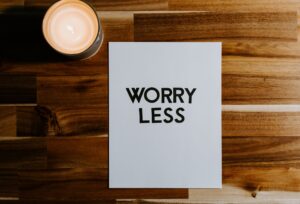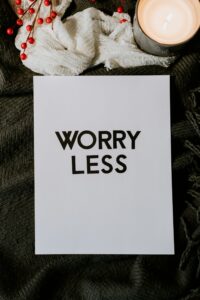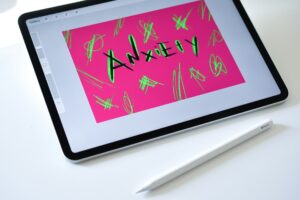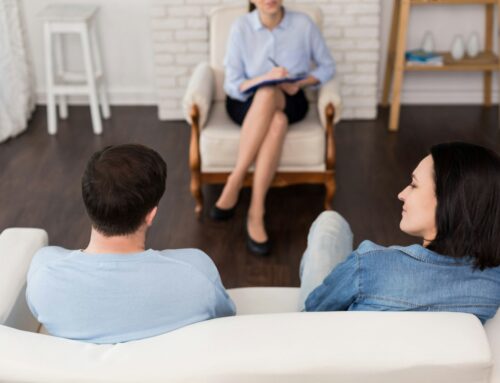Most of us deal with anxiety on some level during our lives. In the past, anxiety helped with the fight-or-flight response to keep our ancestors safe during perilous times. It is ingrained in us. Fast forward to today, and we face anxious thoughts and situations instead of dangerous life-and-death circumstances. Still, our minds work the same way, flooding our bloodstream with cortisol and adrenaline and revving up anxiety.
The symptoms of anxiety can be scary and interfere with daily life:
- Worrying excessively about things outside your control.
- Experiencing mood swings and irritability.
- Tossing and turning at night, unable to sleep.
- Waking up throughout the night.
- Carrying muscle tension.
- Tiring easily.
- Fighting to concentrate.
- Feeling on edge.
- Developing stomach issues and unexplainable aches and pains.
- Feeling panicked.
- Experiencing chest tightness and numbness or tingling in the arms or hands.
- Gaining or losing weight.
Anxiety reduction is the practice of managing anxiety symptoms or receiving treatment.
What You Can Do for Anxiety Reduction
 Aside from counseling, much of what you can do about anxiety reduction is based on lifestyle changes and healthier living. Certain aspects of our lives worsen anxiety. For example, smoking may seem like an easy way to relax. Your brain receives a hit of dopamine, making the behavior feel rewarding. However, over time, nicotine changes the structure of the brain and increases the stress hormone cortisol, exacerbating anxiety.
Aside from counseling, much of what you can do about anxiety reduction is based on lifestyle changes and healthier living. Certain aspects of our lives worsen anxiety. For example, smoking may seem like an easy way to relax. Your brain receives a hit of dopamine, making the behavior feel rewarding. However, over time, nicotine changes the structure of the brain and increases the stress hormone cortisol, exacerbating anxiety.
The following are anxiety reduction strategies you can use starting today. Choose one or two to add to your routine, and when you feel ready, add another one.
Ground Yourself
Anxiety sets in when we worry about the future or relive the past. Grounding yourself in the present will bring you back to reality. This could be as simple as reminding yourself to concentrate on the here and now or using the 5-4-3-2-1 grounding method.
With the 5-4-3-2-1 method of grounding and reducing anxiety, you will focus on five things you can see, four things you can touch, three things you can hear, two things you can smell, and one thing you can taste. Take your time with this exercise, naming each item aloud and touching them to feel their textures. This exercise helps to interrupt intrusive and anxious thoughts.
Deep Breathing
Your breathing becomes shallow while anxious. In the past, this was a mechanism to help you run away from a predator. Today, we don’t have an animal chasing us, so we must concentrate on breathing deeply to relax and soothe tension.
There are several different breathing exercises you can try. To get started, try inhaling through your nose deeply, filling the lungs, holding your breath, and then exhaling slowly through the mouth. You can do this in equal counts (for example, the 4-4-4 method of four counts to inhale, four counts to hold, and four counts to exhale) or try different beats, such as 4-7-8.
Progressive Muscle Relaxation
Muscles tense when we are anxious, preparing our bodies to flee. Unfortunately, we have lost the ability to recognize when our muscles are tense from chronic stress and anxiety. Progressive Muscle Relaxation is a practice that puts us back in tune with our bodies.
To begin, lie on the floor or a bed. Starting with your feet, tense the muscles and hold for five seconds, then relax. Pay close attention to how your feet feel during this exercise. Can you notice the difference between tension and relaxation? Next, move to your calf muscles. Continue scanning each body part this way. Repeat the process for any parts in which you still feel tension.
Set a Sleep Schedule
It is well known that sleep deprivation contributes to the inability to control emotions. Were you ever told as a child to take a nap if you seemed overwhelmed, cranky, or weepy? Sleep and anxiety impact each other. You need sleep to manage your emotions, including anxious thoughts.
Set a sleep schedule and prioritize this time like any other appointment. You may feel tempted to stay up late after a long day or after you put your child to bed, but the brain needs time to recover.
Start by creating a nightly routine. For example, change into your pajamas or shower after dinner, and then go to bed with a book and a cup of herbal tea. Avoid devices at least two hours before bed as the blue light emitted can cause sleep disturbances.
Go For a Walk
 Walking is an effective exercise method that most people can use to lower anxiety. It releases endorphins, like serotonin, that leave you feeling accomplished and happy. Walking is also great for strengthening the lungs and heart, improving concentration and focus, and maintaining a healthy body weight.
Walking is an effective exercise method that most people can use to lower anxiety. It releases endorphins, like serotonin, that leave you feeling accomplished and happy. Walking is also great for strengthening the lungs and heart, improving concentration and focus, and maintaining a healthy body weight.
You can make your walk as low or as high impact as you like. A brisk walk in the morning will set the tone for your day, and an evening stroll after dinner will help with digestion and promote better sleep. Aim to walk most days of the week, even at home on a treadmill or streaming a walking video.
Try Journaling
Journaling is often underrated, but the exercise offers many benefits. Writing down your thoughts allows you to identify and analyze your triggers and work on solutions. It is also a safe place to vent your frustrations, visualize dreams and goals, and make plans.
Try journaling either early in the morning or before bed as part of your nightly routine. Often, it can take two or three pages to get to the heart of the matter, so try freewriting, writing whatever thoughts surface first and delving into those. If you feel comfortable, you can share your journal with your counselor to identify thought patterns that could be triggering your anxiety.
Distract Yourself
If you are the type of person who avoids hobbies and interests when life gets busy, you may feel unfulfilled. This can lead to more anxiety. Hobbies and interests are excellent ways to distract yourself from worry and negative thoughts.
List hobbies and activities you haven’t done in a while or wish you had more time to do and then find pockets of time. For example, work on writing that short story during your fifteen-minute break instead of scrolling Facebook, listen to music, or crochet while dinner is in the oven.
Lift Weights
Often, symptoms of anxiety are weight gain, appetite changes, low self-esteem, and mood irregularities. Resistance training helps to combat these symptoms. Most people find that lifting weights or training with body weight resistance exercises improves mood, defines muscles, normalizes BMI and weight, and results in a stronger body.
Seek clearance from your physician before starting any new exercise program. If you have never lifted weights or haven’t done so in a while, seek the help of a personal trainer to learn proper form. Start with lighter weights until you are stronger.
Eliminate Triggers
 If you can pinpoint your stressors, find ways of eliminating or managing them. You may find that it is a combination of issues that is worsening your anxiety. For example, you may work a job with long hours, sleep four hours a night, and hold positions on two boards. Ask yourself what you can eliminate, delegate, or keep. In this scenario, you could find a job with better hours, prioritize sleep to seven hours a night, and drop one of the board positions.
If you can pinpoint your stressors, find ways of eliminating or managing them. You may find that it is a combination of issues that is worsening your anxiety. For example, you may work a job with long hours, sleep four hours a night, and hold positions on two boards. Ask yourself what you can eliminate, delegate, or keep. In this scenario, you could find a job with better hours, prioritize sleep to seven hours a night, and drop one of the board positions.
The crucial point is to prioritize your mental health. If you feel like you cannot drop anything because people depend on you, remember that people would rather you be healthy and whole than an anxious bundle of nerves. You have to put your health first by carefully selecting what you will allow to occupy your space and time.
Finding Additional Support When You’re Feeling Anxious
Anxiety reduction help is available. Christian counseling combines faith-based principles with advanced psychological methods to ensure that you heal in every aspect: mentally, emotionally, physically, and spiritually. Your counselor will assist you during therapy and teach you lifelong skills and techniques to manage anxiety. Contact us today to get started with anxiety reduction.
“Worry Less”, Courtesy of Kelly Sikkema, Unsplash.com, CC0 License; “Worry Less”, Courtesy of Kelly Sikkema, Unsplash.com, CC0 License; “Anxiety”, Courtesy of Nik, Unsplash.com, CC0 License






